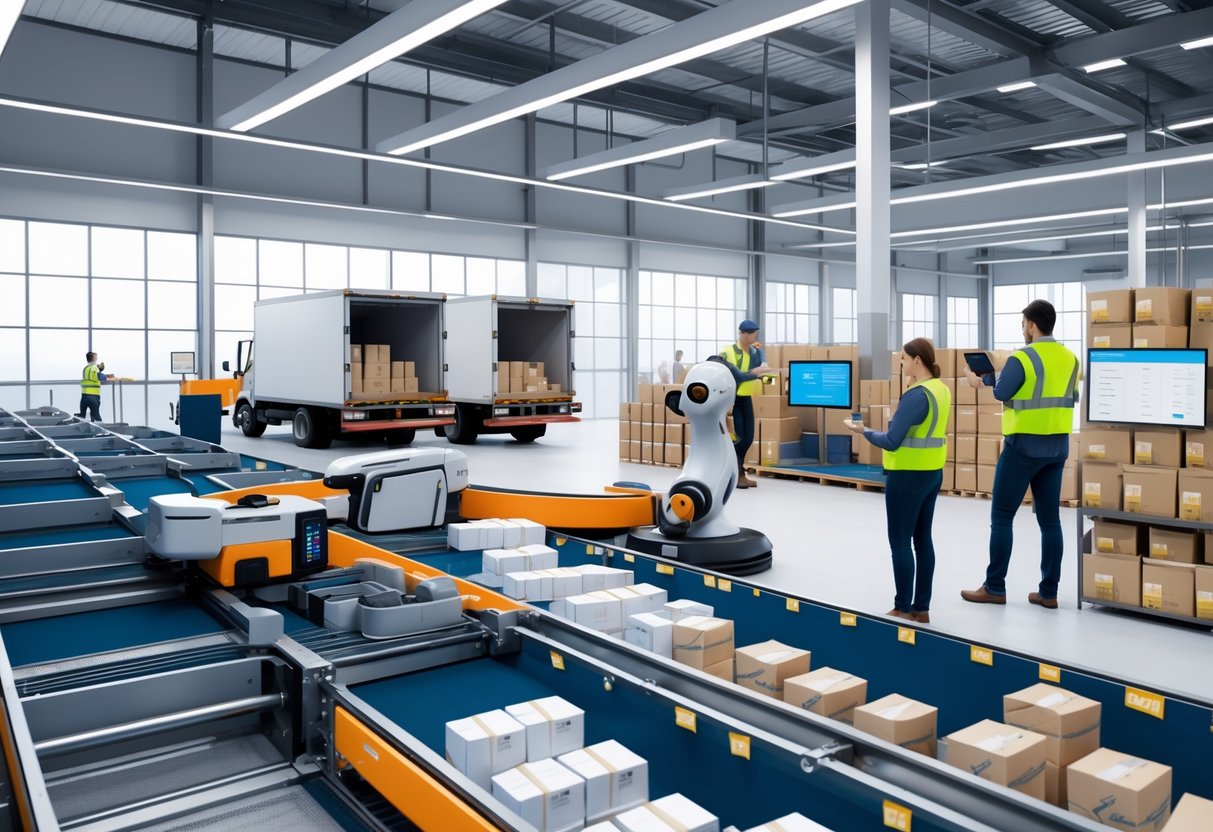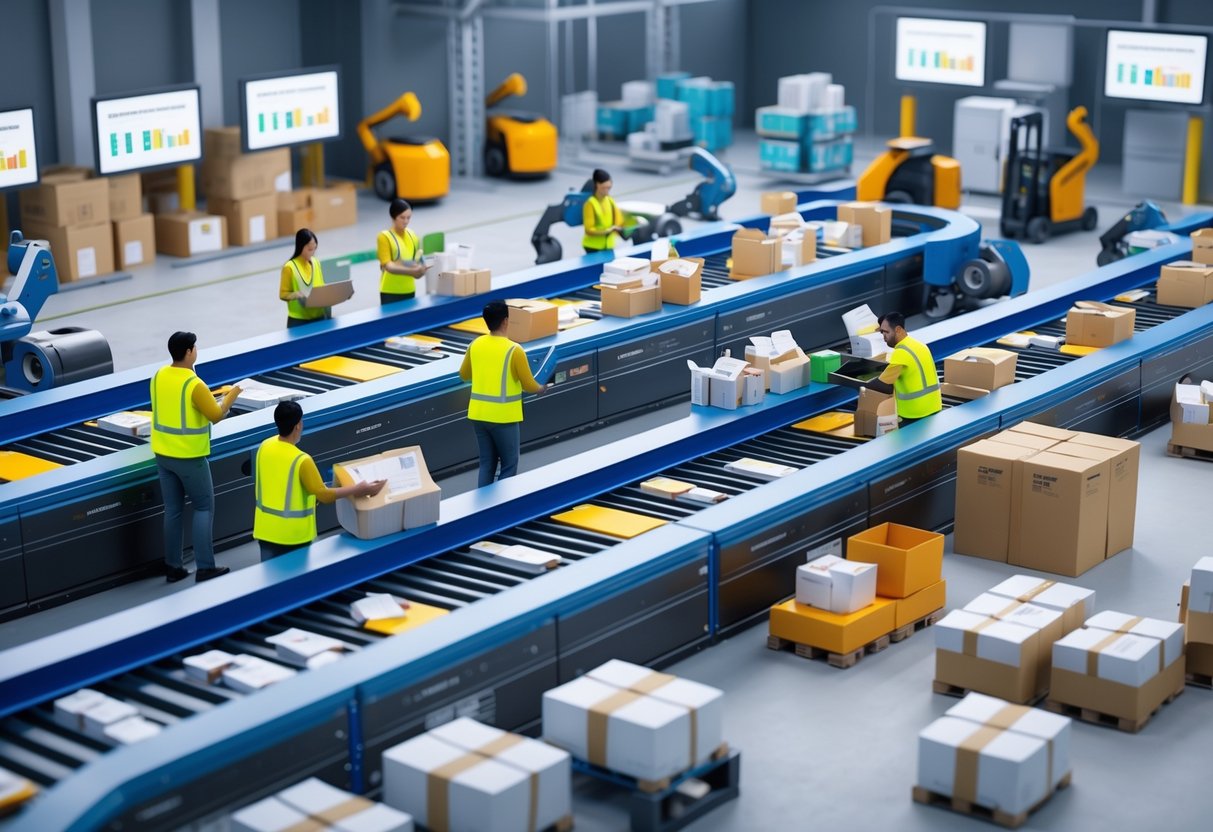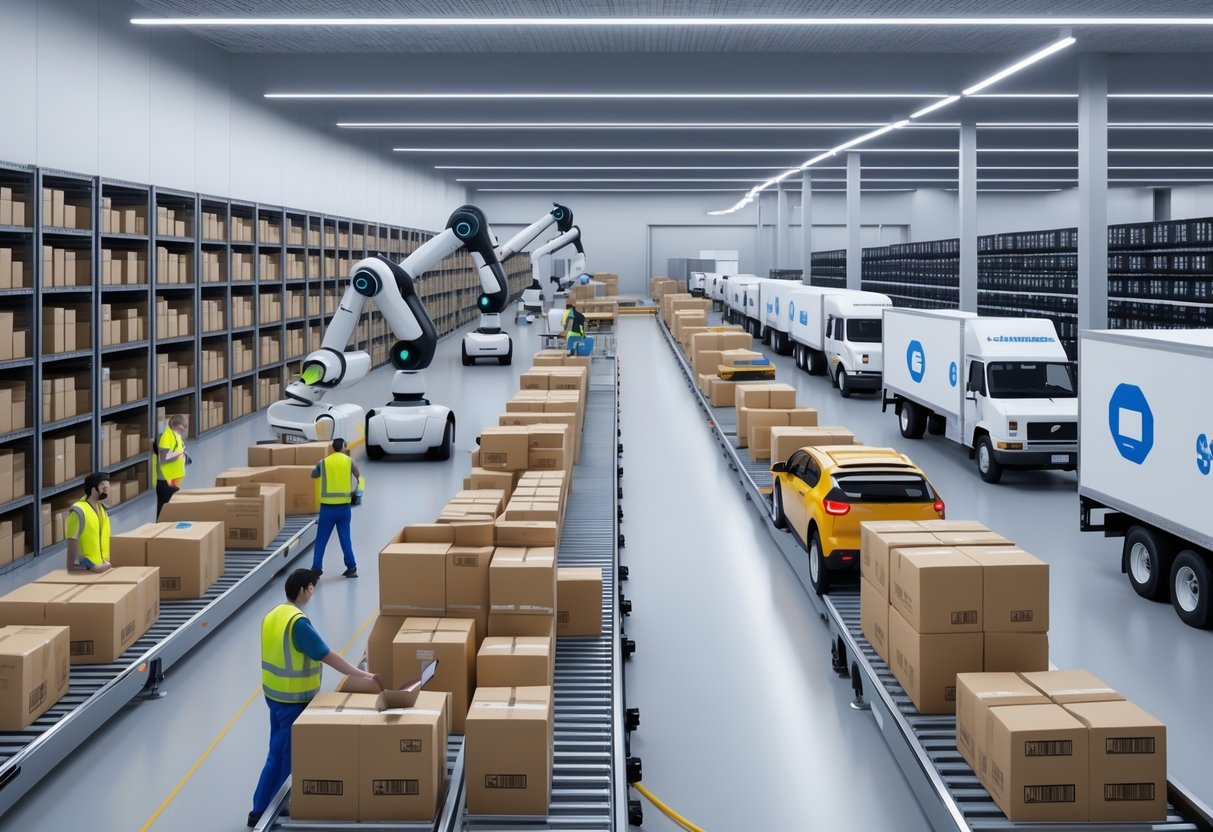Merchandise Logistics: Essential Guide to Efficient Fulfilment
Updated On: November 12, 2025 by Aaron Connolly
Understanding Merchandise Logistics
Merchandise logistics covers the movement of products from suppliers all the way to customers. It’s all about coordinating storage, transportation, and distribution, often through partnerships that keep things running smoothly.
You’ll find that this process demands a lot of teamwork among different players. Most companies rely on specialised logistics pros to keep everything on track.
Core Elements of Merchandise Logistics
Four main pieces really hold merchandise logistics together.
Transportation keeps goods moving. Companies pick vehicles, plan routes, and juggle delivery times. Lorries handle local jobs, ships move stuff across oceans, and railways carry heavy loads.
Warehousing offers safe places for products to sit until someone needs them. Modern warehouses rely on automated systems for tracking inventory and rotating stock. They have to balance storage space with quick access—never as easy as it sounds.
Inventory management makes sure the right products are ready when needed. Teams track stock, forecast demand, and reorder when supplies run low. Real-time data helps avoid running out—or ending up with way too much.
Order fulfilment links customer orders to actual product delivery. Staff pick the items, package them, and arrange shipping. A solid fulfilment system can handle thousands of orders a day with hardly any mistakes.
Key Stakeholders in the Process
Lots of folks have to work together to make merchandise logistics actually work.
Suppliers bring in raw materials or finished goods. They have to sync up their production with transport and keep quality high.
Manufacturers turn those raw materials into products ready to ship. They also handle packaging and coordinate with logistics teams for delivery.
Retailers act as the final bridge to customers. They keep tabs on store inventory, work with distribution centres, and deal with customer issues about product availability.
Customers—well, they drive everything. Their buying habits, delivery demands, and return requests shape how logistics teams plan and execute.
When someone drops the ball, everyone feels it. Delays or quality problems in one spot ripple through the whole supply chain.
The Role of Logistics Partners
Outside logistics partners bring skills and resources that most companies just don’t have in-house.
Third-party logistics (3PL) providers offer full-service warehousing, transport, and order handling. They invest in tech and staff that smaller businesses simply can’t.
Freight forwarders focus on international shipping, customs paperwork, and switching between transport modes. They know how to deal with regulations and red tape in different countries.
Technology providers deliver the software to track inventory, optimise routes, and manage orders. These platforms connect everyone through shared data.
Courier services take care of the last leg, delivering straight to the customer’s door. Their networks of drivers and sorting centres make same-day or next-day delivery possible.
You really have to weigh a partner’s tech, reach, and experience before signing on. The best partnerships grow over time, making things cheaper and more efficient for both sides.
Types of Merchandise and Their Logistics Needs
Different merchandise types need different logistics setups. Physical properties, storage needs, and what customers expect all play a role.
Seasonal apparel cycles move fast, while promotional items come with strict deadlines. Each type brings its own headaches and supply chain puzzles.
Apparel Logistics
Apparel logistics gets tricky thanks to seasonal demand and endless size options. Fashion retailers juggle inventory across sizes, colours, and styles for every piece.
Seasonal Planning Requirements
Fashion brands often plan 6–12 months out, building in time for production and shipping. Spring lines ship in winter. This helps avoid empty shelves when demand hits.
Size and Variant Complexity
Every shirt in five sizes and four colours turns into 20 SKUs to track and store. That’s a lot of moving parts for just one product.
| Challenge | Solution |
|---|---|
| Seasonal demand spikes | Advanced demand forecasting |
| Multiple size variants | Automated sorting systems |
| Return rates (20-30%) | Streamlined reverse logistics |
| Fast fashion cycles | Agile supply chain partners |
Storage Considerations
Hanging garments need different setups than folded ones. Some fabrics need temperature control. Careful handling keeps wrinkles and damage at bay during shipping.
Promotional Merchandise
Promotional merchandise comes with tight deadlines and custom requests. Marketing campaigns set the schedule, and nobody wants to miss a launch.
Time-Sensitive Delivery
Promotional timelines depend on campaign dates. If you miss a product launch or trade show, the whole order loses its value. Sometimes, rush shipping costs more than the products themselves.
Customisation Complexities
Promotional orders often need custom printing, embroidery, or engraving. Quality control really matters, since there’s no time to fix mistakes before an event.
Volume Fluctuations
Orders might be as small as 50 pens or as large as 10,000 branded shirts. You need flexible manufacturing partners and logistics that can scale up or down.
Quality Assurance Protocols
We put stricter checks in place for promotional goods. A single defective item can sour a client relationship and hurt your brand’s reputation.
Branded Merchandise
Branded merchandise demands tight quality control and brand protection from start to finish. These products show off a company’s identity, so the bar is higher than for generic stuff.
Brand Consistency Standards
Every branded item must hit exact colours and logo placements. Partners need training on brand guidelines to keep things consistent at every touchpoint.
Authentication and Security
Counterfeits are a real threat. We use secure packaging and trusted dealer networks to keep unauthorised goods out of the market.
Premium Packaging Requirements
Branded merchandise often comes in special packaging that matches the brand’s values. Sustainable packaging is getting more popular, protecting products and showing social responsibility.
Global Distribution Challenges
When shipping internationally, branded goods have to meet local rules and still look and feel on-brand. Sometimes, you need to tweak products or packaging for different countries.
Product Mix and SKU Complexity
Managing a big product mix can make logistics a nightmare. Each new SKU means more to store, track, and ship.
SKU Proliferation Management
Too many SKUs drive up costs without always boosting sales. We regularly review performance and cut slow movers to keep inventory lean.
Inventory Allocation Strategy
Different categories need different stock levels. Fast sellers need more backup, while specialty items can get by with less.
Warehouse Layout Optimisation
Warehouses need smart zoning. Fast movers stay close to packing, while seasonal stuff goes in flexible areas.
| Product Type | Storage Method | Pick Frequency | Special Requirements |
|---|---|---|---|
| Apparel | Hanging/folded | Medium | Size sorting, seasonal |
| Electronics | Shelf storage | High | Security, anti-static |
| Promotional | Bulk bins | Low | Custom packaging |
| Fragile items | Protective cases | Variable | Special handling |
Technology Integration Needs
A complex product mix calls for solid warehouse management systems. Barcode scanners and automated sorting help cut down on picking mistakes.
Warehousing Solutions for Merchandise
Good warehousing is the backbone of merchandise logistics. Facilities need smart locations, flexible storage, and efficient receiving to handle all kinds of products.
Distribution Centres
Distribution centres act as the main hubs, linking manufacturers with retailers and customers. We pick locations near major transport networks to cut down shipping times and costs.
Most centres run between 100,000 and a million square feet. They might handle everything from clothing to electronics under one roof.
Key features include:
- Cross-docking for quick-moving products
- Multiple temperature zones for different needs
- Advanced sorting to speed up orders
- Connections to major carriers
Location matters. Centres within 50 miles of big cities can promise same-day or next-day delivery.
During busy seasons, lots of centres run 24/7. This helps them keep up with higher order volumes.
Storage Options
Warehouses need flexible storage for products of all shapes and sizes. We design layouts to use every inch but still make picking easy.
Standard storage methods include:
| Storage Type | Best For | Space Efficiency |
|---|---|---|
| Selective racking | Mixed SKUs | 85% |
| Drive-in racking | High-volume items | 95% |
| Mezzanine floors | Small goods | 90% |
| Floor stacking | Bulk merchandise | 75% |
Climate-controlled areas protect sensitive stuff like electronics and leather. These zones keep temperature and humidity steady.
Automated storage can really speed up picking for fast movers. It can shave picking times by up to 60%.
Security is a must—CCTV, access controls, and inventory tracking all help keep shrinkage down.
Receiving Procedures
A smooth receiving process gets merchandise into storage quickly and accurately. We use standard steps to keep inventory right and costs down.
Standard receiving workflow:
- Schedule appointments with suppliers
- Inspect goods when they arrive
- Check quality and look for damage
- Scan barcodes and update systems
- Put products in their assigned spots
Dock management systems help coordinate incoming deliveries. This prevents traffic jams and long waits at the dock.
Quality checks catch damaged goods before they get mixed in. That saves headaches and returns later.
Real-time updates keep inventory levels accurate across all channels. Integrating with management systems cuts down on manual errors.
Cross-docking skips regular storage for fast movers. Goods go straight from receiving to shipping, sometimes within a day.
Inventory and Stock Management
Inventory management is really at the heart of merchandise logistics. Modern tracking gives real-time stock visibility, and managing at the SKU level keeps everything tight.
Inventory Tracking Systems
New tracking systems have changed the game for monitoring inventory. Digital platforms now show real-time updates on stock movement and locations.
Barcode and RFID Integration
Most teams use a mix of barcode scanning and RFID. That combo keeps things accurate and cuts down on manual mistakes.
RFID tags bring some handy perks:
- Automatic scanning—no need for a direct line of sight
- Bulk reading—scan a whole group at once
- Real-time tracking inside warehouses
Cloud-Based Solutions
Cloud inventory management is getting more popular. These systems scale easily and plug into other business tools.
You get automatic data sync across sites and simple integration with enterprise systems through APIs.
Stock Level Visibility
Clear stock visibility stops you from running out or piling up too much. We need real-time info to make smart restock decisions.
Dashboard Analytics
Modern dashboards show current stock, reorder points, and demand forecasts. These tools help teams spot trends and fix issues fast.
Automated Alerts
Smart systems send alerts when stock drops too low. This helps avoid last-minute orders that usually cost more.
Multi-Location Tracking
If you’ve got more than one warehouse or store, central tracking is key. We can check stock across all locations from one screen.
This big-picture view makes it easier to shift inventory where it’s needed most.
SKU-Level Management
SKU-level management gives you granular control over individual product variants. With this detailed approach, you can optimise inventory investment but still keep service levels high.
Product Performance Analysis
We track each SKU’s performance—turnover rates, profit margins, and seasonal trends all get measured. This information guides purchasing and flags slow-moving stock.
Demand Forecasting
Advanced systems look at historical data and market trends to predict demand for each SKU. Over time, machine learning algorithms get better by learning from real sales data.
Automated Reordering
Smart reordering systems figure out optimal order quantities by factoring in lead times, demand swings, and storage costs. Automation here means less manual work, but you still maintain healthy stock levels.
| SKU Management Feature | Benefit |
|---|---|
| Performance tracking | Identifies profitable products |
| Demand forecasting | Prevents stockouts |
| Automated reordering | Reduces manual errors |
| Variant analysis | Optimises product mix |
Retailers often see big cost reductions and happier customers after rolling out robust SKU-level management.
Order Fulfilment Strategies

Getting merchandise from the warehouse to fans takes careful planning and smart distribution choices. Let’s look at the basics: pick and pack operations, multi-channel approaches that reach customers everywhere, and custom packaging that makes unboxing actually feel special (see more).
Pick and Pack Processes
Pick and pack sits at the heart of merchandise distribution. Staff select items from shelves, check orders for accuracy, and get packages ready for shipment.
Batch picking means grouping similar orders together. Staff grab multiple items at once, then sort them into individual packages. It’s efficient for high-volume operations.
Zone picking splits warehouses into sections, with each worker handling a specific area. Orders move along an assembly line—gaming companies use this a lot for mixed merch orders.
Wave picking schedules order processing in batches throughout the day. Busy times like tournament launches or new releases need good wave planning to keep up with spikes.
Modern warehouses use barcode scanning and pick-to-light systems to cut errors and speed things up. You might pay anywhere from £2,000 for basic scanners up to £50,000 for full automation.
Quality control checkpoints catch mistakes before shipping. Staff double-check items against orders, look for damage, and confirm shipping addresses. This step helps avoid costly returns and keeps customers happy.
Omnichannel Fulfilment
Omnichannel fulfilment ties together multiple sales channels under one order management system. Fans can buy through websites, apps, retail stores, or marketplaces and still get consistent service.
Inventory visibility across all channels stops overselling. When stock runs low, the system updates every platform automatically. That way, customers aren’t surprised by out-of-stock notices after they’ve paid.
Ship-from-store turns retail shops into mini distribution centres. Local stores fulfil online orders, speeding up delivery and cutting shipping costs. Many gaming retailers deliver merch within a day using this setup.
| Fulfilment Method | Delivery Time | Cost Range | Best For |
|---|---|---|---|
| Central warehouse | 2-5 days | £3-8 | Standard orders |
| Local store | 1-2 days | £5-12 | Urgent requests |
| Click & collect | Same day | Free | Convenience shoppers |
Cross-channel returns let customers return items anywhere—buy a gaming chair online, drop it off at a store. This makes things easier for customers and lowers return shipping costs.
Real-time order tracking gives updates across all channels. Customers get the same info whether they check online, use the app, or call support.
Custom Kitting and Packaging
Custom kitting bundles items into special sets before shipping. Gaming companies use this for collector’s editions, tournament prizes, and seasonal gift sets.
Pre-assembly kitting puts together popular bundles ahead of time. Limited edition gaming peripherals and exclusive merch get packaged together during slow periods. That way, fulfilment is faster when demand spikes.
On-demand kitting builds custom packages as orders come in. Customers might pick their favourite mouse, mousepad, and sticker pack—staff assemble these when the order arrives.
Branded packaging makes unboxing memorable. Custom boxes, tissue, and branded tape turn delivery into a mini marketing moment. Quality packaging costs £0.50-3.00 per order, but it really shapes customer perception.
Protective packaging keeps merchandise safe. Gaming hardware needs foam inserts and anti-static bags. Clothing gets poly mailers or boxes, depending on value and expectations.
Seasonal packaging changes for special events and tournaments. Championship-themed boxes or holiday packaging add that extra touch fans love.
Sustainable options—like recycled materials and minimal waste designs—are getting popular. More gaming companies now offer eco-friendly packaging, which appeals to eco-conscious customers and cuts disposal costs.
Automation and Technology in Merchandise Logistics

Modern merchandise logistics leans heavily on automated systems and smart technology to move products from suppliers to customers. These tools cut errors, speed things up, and help keep costs down across warehouses and distribution centres.
Warehouse Automation
Automated Storage and Retrieval Systems (AS/RS) have changed how we store and move merchandise. Robotic cranes and conveyors now handle products with little human help.
You’ll find a few main pieces in these systems:
- Robotic picking systems pull items from shelves
- Conveyor belts move goods between areas
- Automated sorting machines organise products by destination
Companies save a lot of time with these systems. What used to take hours now takes minutes.
Packaging automation matters too. Machines can weigh, seal, and label packages faster than people. This cuts labour costs and keeps things consistent.
The biggest perks: fewer handling errors and faster order processing. Of course, smaller operations might find the setup costs a bit steep.
Barcode and Scanning Systems
Barcode technology drives modern merchandise tracking. Every product gets a unique code with key info about the item.
We use a few types of scanning systems:
| System Type | Best For | Key Advantage |
|---|---|---|
| Handheld scanners | Small warehouses | Portable and affordable |
| Fixed scanners | Conveyor systems | Hands-free operation |
| Mobile computers | Large facilities | Combines scanning with data access |
Radio Frequency Identification (RFID) tags go even further. Unlike barcodes, RFID doesn’t need direct line-of-sight, so we can scan several items at once.
This tech helps prevent expensive mistakes. When workers scan items, the system checks the product against the order instantly.
Real-time tracking means we always know where each item is in the warehouse.
Inventory Management Software
Digital inventory systems have replaced old manual tracking. These programs connect right to barcode scanners and automated equipment for smooth operation.
Key features:
- Automatic reorder alerts when stock runs low
- Demand forecasting using sales history
- Real-time stock updates across every location
The software helps you avoid both stockouts and overstock. Predictive analytics can even tell you what you’ll need and when.
Integration capabilities let the system talk to suppliers, shippers, and sales platforms. That gives you a full view of merchandise flow from order to delivery.
Most systems offer mobile access so managers can check inventory from anywhere. Cloud-based solutions mean you don’t need pricey on-site servers.
You’ll usually see a return on investment within a year, thanks to lower carrying costs and fewer stock errors.
Sourcing and Supply Chain Integration

Smart sourcing and supply chain integration sit at the heart of good merchandise logistics. It’s about picking the right suppliers, keeping your entire supply network visible, and controlling lead times so you can meet customer demand.
Supplier Selection and Procurement
Choosing the right suppliers lays the groundwork for logistics. We have to look past just price when sizing up potential partners.
Key selection criteria:
- Quality standards and certifications
- Production capacity and scalability
- Financial stability and track record
- Geographic location and shipping capabilities
- Sustainability practices and ethics
Building strong relationships with suppliers means regular communication and shared goals. Quarterly reviews help us talk through performance, challenges, and improvements.
Procurement best practices:
- Diversify your supplier base to lower risk
- Negotiate clear contracts with firm quality standards
- Use supplier scorecards to track performance
- Have backup suppliers ready in case of trouble
Tech makes procurement easier. Digital platforms let us compare suppliers, track orders, and manage contracts quickly.
End-to-End Supply Chain Visibility
Total visibility across your supply chain means you always know where your products are. This transparency helps us make better decisions and react fast when things go wrong.
Visibility essentials:
- Real-time inventory tracking
- Production status updates
- Transportation monitoring
- Quality control checkpoints
Digital tools like RFID tags and GPS tracking send instant updates on product locations. Cloud-based systems let everyone on the team see the same info at once.
Systems need to talk to each other. When procurement software links with inventory management, we close data gaps and cut down on mistakes.
Benefits of full visibility:
- Faster response to disruptions
- Better demand forecasting
- Lower inventory holding costs
- Improved customer satisfaction
Dashboards that show key metrics at a glance help us spot trends and catch problems early.
Managing Lead Times
Lead time management shapes how well we meet customer expectations. Shorter lead times give us an edge, but they take careful coordination.
What affects lead times:
- Supplier production schedules
- Transportation methods and routes
- Customs and regulatory requirements
- Quality inspection steps
We can cut lead times with smart planning. Working closely with suppliers helps us understand their limits. Planning ahead avoids last-minute scrambles and extra costs.
Lead time reduction strategies:
- Use local suppliers when you can
- Implement just-in-time delivery
- Standardise product specs
- Keep safety stock for critical items
Communication matters. When delays happen, we need systems that alert customers right away and update delivery estimates.
Seasonal peaks need extra lead time planning. By checking past data, we can predict busy periods and adjust sourcing schedules.
Logistics Partnerships and Outsourcing

The right partnerships can turn merchandise logistics from a headache into a smooth, scalable system. A good logistics partner gives you access to warehouses, shipping networks, and expert teams—without a massive upfront spend.
Choosing a Logistics Partner
Finding the right logistics partner takes a close look at what you need and what they offer. Start with a list of your biggest challenges and your growth goals.
What to look for:
- Geographic coverage that matches your customers
- Technology that fits with your systems
- Scalability for peak seasons and growth
- Experience with your product types
- Transparent cost structure
Most partnerships start small. Test new partners with a single product line or region before you go all in.
Check their warehouse locations against your shipping zones. Partners with facilities near your customers can shave off 1-2 days from delivery and cut shipping costs.
Red flags:
- Vague pricing
- Poor communication up front
- Weak technology
- No references from similar businesses
Ask for detailed proposals from three to five partners. Compare how they handle inventory, speed, and customer service.
3PL and Fulfilment Centre Services
Third-party logistics (3PL) providers can take over your entire warehousing operation with complete fulfilment solutions. They handle inventory storage, order processing, packaging, and shipping management, so you don’t have to.
Core 3PL services include:
- Inventory receiving and storage
- Order picking and packing
- Shipping carrier management
- Returns processing
- Real-time inventory tracking
Fulfilment centres focus on fast order processing for e-commerce businesses. Most ship orders within 24 hours, and some even manage same-day processing if you beat their cut-off times.
Pricing models are all over the place. Some providers charge per transaction, while others go with monthly storage plus handling fees. Honestly, hybrid models usually suit growing businesses best.
Technology integration is crucial. Make sure your fulfilment centre connects smoothly with your e-commerce platform. That way, customers get automatic inventory updates and tracking info.
Many providers also throw in value-added services like gift wrapping, custom packaging, or kitting. These extras let you stand out without stretching your own team.
Dedicated Account Support
Dedicated account managers become your main point of contact for logistics. They provide personalised service and help solve problems quickly.
This support model shines for businesses with complex needs or lots of orders.
Benefits of dedicated support:
- Single point of contact for all issues
- Proactive communication about potential problems
- Customised reporting and analytics
- Priority handling during peak periods
Account managers regularly review your business, digging into performance metrics and looking for ways to improve. We suggest at least monthly check-ins and weekly calls during busy times.
Find partners who assign experienced account managers from your industry. They should get your customer expectations and seasonal swings right from the start.
Response time commitments matter. The best providers promise fast responses—usually within an hour for urgent stuff, and within four hours for routine questions.
Many logistics partners offer client portals. You can track shipments, watch inventory, and pull up detailed reports. These tools give you 24/7 visibility and back up your support team.
Managing Returns and Reverse Logistics

How you handle returns has a direct impact on customer satisfaction and costs. You need solid procedures for processing returned items, restocking salvageable products, and keeping customer relationships strong.
Returns Handling Procedures
Clear systems make processing returned merchandise faster and more accurate. Every returned item should get inspected within 24-48 hours to figure out its condition and what to do next.
Standard processing workflow:
- Initial inspection and categorisation
- Condition assessment (new, damaged, defective)
- Documentation of return reason
- Decision routing (restock, refurbish, dispose)
Most businesses sort returns into three tiers. Tier 1 items go straight back to regular stock. Tier 2 products need a quick clean or repackaging. Tier 3 items get refurbished or tossed.
Stock management systems track returned inventory separately from new products. This keeps damaged goods out of regular stock and keeps your inventory counts right.
Order fulfillment teams need to see return status data. That way, they don’t accidentally ship items already returned or in dispute.
Restocking and Refurbishment
Quick restocking decisions cut storage costs and free up warehouse space. We check each returned item against set criteria before putting it back into inventory.
Restocking criteria checklist:
- Original packaging intact
- No visible wear or damage
- All accessories included
- Within acceptable return timeframe
Items needing refurbishment get their own handling steps. A bit of cleaning, minor repairs, or new packaging can turn many returns back into sellable goods.
Keep refurbishment costs under 15-20% of the selling price. If it costs more, you’re probably better off clearing or disposing of the product.
Warning: Don’t restock anything without a quality check. Otherwise, you’ll just see the same items returned again—and customers won’t be happy.
Customer Service Considerations
Customers remember how you handle returns. Make the process easy and keep communication open.
Prepaid return labels make life easier for customers and usually pay off with better retention.
Status updates keep customers in the loop and reduce support calls. Automated emails at key stages (received, processed, refund issued) work for most businesses.
Quick win: Give customers options—let them drop off in-store, arrange courier collection, or use postal returns.
Train your staff so service stays consistent at every return touchpoint. Customer service teams should have the authority to fix common issues fast.
Order fulfillment data can highlight products with high return rates. Use this info to make better purchasing decisions and push suppliers to improve quality.
Merchandise Logistics for Online and Retail Channels

Modern merchandise logistics now runs across both online and brick-and-mortar channels. Each one needs its own distribution strategies and fulfilment processes to get products to customers efficiently.
E-Commerce Distribution Models
Online logistics mostly revolves around direct-to-consumer shipping from central fulfilment centres. You’ll usually see three main models.
Hub-and-spoke distribution sends orders from one central warehouse to customers nationwide. It’s great for smaller operations with consistent products. Shipping costs stay predictable, but delivery times can swing depending on location.
Regional distribution uses fulfilment centres in key areas. This setup shortens shipping times and usually lowers costs for most customers. Many growing businesses switch to this once their order volume justifies it.
Third-party logistics (3PL) lets companies use existing distribution networks. We see this a lot with seasonal products or when businesses test new markets. The 3PL handles warehousing, picking, packing, and shipping, while you keep the customer relationship.
Drop-shipping is another option. Suppliers ship directly to customers, so you don’t need to invest in inventory. The downside? You lose control over packaging and delivery timing.
Brick-and-Mortar Store Support
Physical stores need a different approach, focusing on bulk deliveries and regular inventory top-ups. We organise these operations around what each store needs, not individual customers.
Store replenishment follows sales data and seasonal trends. Distribution centres send cases or pallets on set schedules, which keeps per-unit shipping costs down.
Cross-docking sorts incoming merchandise right away for redistribution to stores. Products barely touch the warehouse, moving quickly from suppliers to retail shelves. This works best for fast-moving stock with steady demand.
Emergency restocking is for demand spikes or supply hiccups. We keep buffer inventory at regional points for quick deployment. It prevents lost sales from stockouts, but does raise carrying costs.
Store-level logistics also include reverse flows—returns, damaged goods, and seasonal merchandise heading back to distribution centres.
Omnichannel Coordination
To keep logistics running smoothly, we integrate online and offline channels with shared inventory and flexible fulfilment.
Inventory visibility across channels stops overselling and keeps stock info accurate. Real-time systems update inventory as sales happen anywhere. This is critical during busy seasons or promos.
Buy online, pick up in store (BOPIS) gives customers convenience and instant gratification. Stores get online orders through the same system as regular replenishment. Staff pick and prep orders for collection, cutting shipping time and cost.
Ship from store turns retail locations into mini fulfilment centres. When online stock runs low, stores can fill web orders from their own shelves. This boosts inventory use across the network.
Unified returns processing lets customers return online buys in-store or ship store purchases back to fulfilment centres. We design reverse logistics to handle these mixed flows without frustrating customers.
Performance Metrics and Optimisation

Tracking the right metrics helps logistics teams spot problems early and make better decisions about inventory and orders. We focus on order accuracy, delivery speed, and finding ways to get better over time.
Key Performance Indicators (KPIs)
We keep an eye on several core metrics to see how well our logistics are working. Order Cycle Time measures how long it takes from order to delivery. We just subtract the order date from the delivery date.
Inventory Turnover shows how fast we sell through our stock. It’s the cost of goods sold divided by average inventory value. Higher turnover means we’re not sitting on too much stock.
The Perfect Order Rate rolls a bunch of things into one score. We count orders that arrive on time, with the right items, and in good condition. This gives us a clear picture of our system’s performance.
Fill Rate checks if we can complete orders right away. We divide units delivered by units ordered, then multiply by 100. Low fill rates mean missed sales or backorders.
On-Time Delivery Rate tracks reliability. We divide on-time orders by the total and multiply by 100. Customers really notice this one.
Order Accuracy and Timeliness
Accurate orders start with solid inventory management. We use barcode scanning and regular counts to keep system records matching what’s actually in stock. That way, we don’t oversell.
Inventory Accuracy compares what we count to what the system says. We aim for 95% or better to avoid stockouts and unhappy customers. Regular cycle counting helps us catch mistakes early.
Processing speed depends on efficient workflows. We measure the time from order receipt to shipment. Most orders should ship within 24-48 hours in normal periods.
Stockout Rate tracks how often we run out of hot items. We watch this per order cycle to spot forecasting issues. High rates hurt loyalty and sales.
Seasonal planning is huge for products with predictable demand spikes. We look at past data to prep inventory for busy times like game launches or tournaments.
Continuous Improvement Strategies
We review performance data every week to catch trends and fix issues fast. Root cause analysis helps us figure out why metrics drop so we can stop it from happening again.
We track supplier performance to make sure partners hit quality and timing standards. We measure on-time delivery and defect rates. Bad suppliers can really hurt customer satisfaction.
Tech upgrades usually bring the biggest improvements. Warehouse management systems cut picking errors and speed up processing. Automated reorder points help us avoid stockouts.
Cross-training staff makes us more flexible during busy times. Team members who know multiple jobs can switch tasks as needed.
We collect customer feedback to catch problems our own metrics might miss. Surveys about delivery speed, packaging, and order accuracy help us spot new opportunities.
For cost reduction, we target the biggest expenses first. We look at freight costs per unit and total supply chain costs as a percentage of sales to find savings.
Current Challenges and Future Trends

Merchandise logistics is changing fast. Businesses juggle seasonal workforce needs, environmental pressures, and new tech. Companies have to balance cost control and customer demands while adapting to automation and sustainability.
Labour and Peak Season Management
Finding enough workers during peak periods is still one of the toughest challenges in logistics. Busy seasons like Christmas or back-to-school can triple warehouse demand overnight.
Companies now use flexible staffing models. They hire temps, partner with agencies, and offer overtime incentives to permanent staff. Some warehouses even dangle sign-on bonuses of £500-1,500 to pull in seasonal workers.
Training challenges add to the mix. New hires need a few days to learn safety and picking systems. Mistakes or slow work from inexperienced staff drag down productivity.
Automation helps take the edge off labour shortages. Automated sorters and robotic pickers handle more volume without extra people. But, these systems come with steep upfront costs—sometimes £100,000-500,000 for smaller operations.
Key strategies include:
- Cross-training permanent staff for multiple roles
- Using predictive analytics to forecast staffing needs
- Implementing flexible shift patterns
- Partnering with local employment agencies early
Smart planning starts months ahead of peak season. The most successful companies begin recruiting in August to prep for Christmas.
Sustainability in Merchandise Logistics
Environmental concerns shape big decisions in merchandise logistics now. Customers care more about green practices, and regulations keep nudging companies toward cleaner operations.
Packaging waste keeps giving everyone headaches. E-commerce exploded, so cardboard and plastic use shot up. Companies try switching to recyclable materials and right-sized packaging to keep waste down.
Transportation emissions make up about a third of logistics’ carbon footprints. Some firms are rolling out electric delivery vehicles for last-mile routes. But electric lorries still don’t go far enough and cost more than diesel ones.
Warehouse sustainability usually means chasing energy efficiency. LED lighting, solar panels, and smart heating systems can cut energy costs by 20-40%. A few companies manage carbon-neutral operations using renewable energy and carbon offset programs.
Green logistics initiatives look like this:
- Consolidating shipments to cut down on transport runs
- Using biodegradable packaging
- Running return programs for packaging
- Optimising delivery routes to burn less fuel
Consumer pressure drives a lot of these changes. About 55% of shoppers say they’ll pay more for sustainable packaging, so green logistics gives brands an edge.
Emerging Technologies
New technology is shaking up merchandise logistics. Artificial intelligence, automation, and data analytics help companies move faster and cut costs—while still meeting what customers want.
AI and machine learning help with demand forecasting and inventory management. These systems look at sales patterns, weather, and market trends to guess stock needs. Companies can cut overstock by up to 30% and avoid running out of products.
Warehouse automation isn’t just for the big players anymore. Smaller companies now lease robotic systems. Automated guided vehicles (AGVs) and pick-and-pack robots handle 60-80% of repetitive tasks.
Real-time tracking has become the norm. IoT sensors keep tabs on shipment location, temperature, and handling all the way through the supply chain. Customers expect live updates, and companies use this data to tweak their service.
Blockchain technology brings more transparency to supply chains. It creates tamper-proof records of product movement, which helps with authenticity checks and recall management.
Technology adoption priorities include:
- Cloud-based inventory management
- Predictive maintenance for equipment
- Voice-directed picking systems
- Automated returns processing
Small and medium businesses usually start with affordable inventory management software (£50-200 monthly), then look at pricier automation down the road.
Frequently Asked Questions

Managing merchandise logistics means tackling challenges like delivery delays, inventory control, and cost management. These practical solutions help businesses streamline operations and keep customers happy.
How can I ensure timely delivery of goods to customers?
Route optimisation software can shave 20-30% off delivery times. These systems find the best routes by factoring in traffic, stops, and driver locations.
Real-time tracking platforms let you and your customers see shipment status instantly. This transparency sets expectations and cuts down on customer service calls.
Electronic proof of delivery (ePOD) systems get rid of paperwork delays. Drivers snap digital signatures and photos on the spot, confirming delivery without manual processing.
Set up automated alerts for delays. If weather, traffic, or breakdowns pop up, customers get notified right away—not after the delivery window closes.
Try using multiple carriers for different delivery zones. Local carriers often know their regions best and can move packages faster than the big national players.
What are the best practices for managing inventory in a warehouse?
Use barcode or RFID tracking for real-time inventory visibility. These tools sync with your logistics software and show accurate stock levels everywhere.
Cycle counting beats shutting down for a full inventory. Divide the warehouse into sections and count as you go, so operations never have to stop.
Keep fast-moving items close to the shipping area. This simple move speeds up picking and boosts efficiency.
Set up automatic reorder points based on sales and lead times. Your system should send purchase orders before stock runs dangerously low.
Hold 10-20% safety stock for essentials. This buffer helps when demand spikes or suppliers run late.
Check inventory turnover rates every month. If something sits more than 90 days, it might need a sale or a new storage plan.
Could you suggest ways to reduce shipping costs for international orders?
Consolidate shipments when you can to get better rates. Shipping 10 items together costs less per unit than sending 10 separate packages.
Compare LTL (Less Than Truckload) and FTL (Full Truckload) options. FTL works best for loads over 15,000 pounds, while LTL fits 150-15,000 pound shipments.
Work with freight forwarders who know international logistics. They’ve got the right carrier connections and get customs requirements.
Set up regional distribution centers in key markets. Keeping inventory closer to customers shortens shipping distances and saves money.
Use shipping software that compares rates across multiple carriers. Price differences can be huge, especially for international routes.
Negotiate volume discounts with your favorite carriers. If you ship a lot, you can get rates 15-25% below standard pricing.
What strategies might one employ to enhance the efficiency of a supply chain?
Automation cuts manual processing time and errors. Auto-allocation systems assign orders to the nearest drivers without anyone stepping in.
Integrate all your systems across the supply chain. When inventory, ordering, and shipping platforms talk to each other, you avoid duplicate data entry and delays.
Use demand forecasting to predict inventory needs better. This helps prevent both stockouts and excess inventory costs.
Try a delivery automation platform that coordinates operations, development, and logistics teams. This central approach boosts communication and decision-making.
Watch key performance indicators like on-time delivery and order accuracy. Tracking these early helps you spot bottlenecks before customers feel the pain.
Consider PUDO (Pick Up and Drop Off) locations for final delivery. This reduces failed delivery attempts and gives customers more convenient pick-up spots.
Can you explain the impact of e-commerce on inventory management?
E-commerce forces you to track inventory in real time across multiple sales channels. You need to know stock levels whether customers buy online, in-store, or on marketplaces.
Same-day and next-day delivery expectations mean you’ll hold more inventory in local distribution centers. This setup is more complicated but speeds up delivery.
BOPIS (Buy Online, Pick up In Store) and BORIS (Buy Online, Return In Store) blur the line between warehouses and stores. Retail locations now act as mini-fulfillment centers.
Returns processing gets more complicated with e-commerce. You need systems that quickly inspect, restock, or dispose of returned items to keep inventory accurate.
Seasonal demand spikes hit harder online. Peak shopping times like Black Friday need flexible inventory strategies and surge planning.
Customers now expect to see their order status at every step. Real-time tracking, from purchase to delivery, is just standard service these days.
What steps should one take to resolve customs clearance issues quickly?
Double-check that your documentation is complete and accurate before you ship anything. Honestly, most customs delays happen because of missing or wrong paperwork.
Try working with freight forwarders who know the ropes and get how things work in your destination country. They’ll usually sort out the right documents and can spot issues before they blow up.
Always use the correct harmonised system (HS) codes for your products. If you mess up the classification, you’ll probably run into delays or even get hit with penalties.
Describe your products and their values in detail. If you just write something vague—like “machine parts”—you’ll almost guarantee a customs inspection.
Keep digital copies of your shipping documents somewhere you can grab them fast. Customs officials might suddenly ask for more info, and any holdup can get expensive.
Think about hiring a customs broker in the country you’re shipping to. Their local know-how can really help you get through the process faster and avoid headaches.

